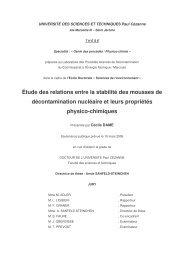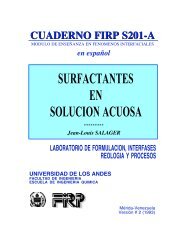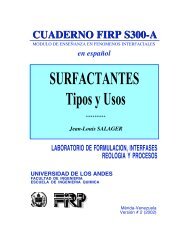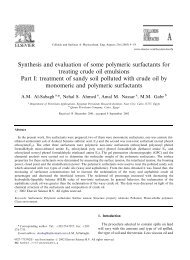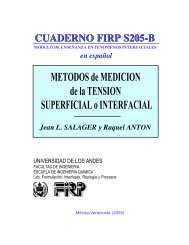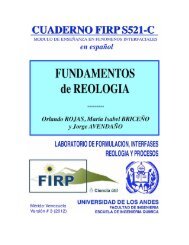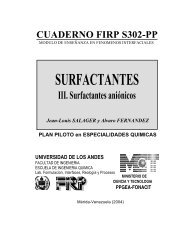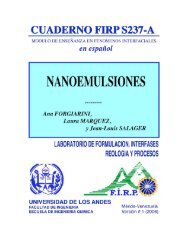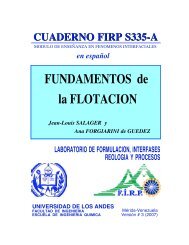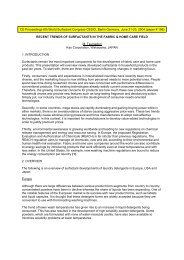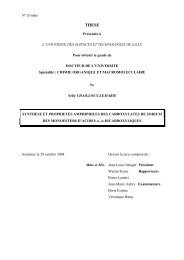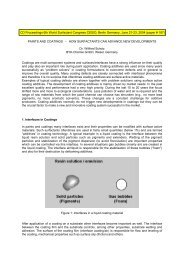Solubilization-emulsification mechanisms of detergency
Solubilization-emulsification mechanisms of detergency
Solubilization-emulsification mechanisms of detergency
You also want an ePaper? Increase the reach of your titles
YUMPU automatically turns print PDFs into web optimized ePapers that Google loves.
C.A. Miller and K.H. Raney/Colloids Surfaces A: Physicochem. Eng. Aspects 74 (1993) 169-215 187<br />
have recently been performed. Experiments<br />
were designed to investigate the effects <strong>of</strong><br />
changes in temperature on the dynamic<br />
phenomena which occur when aqueous<br />
solutions <strong>of</strong> pure non-ionic surfactants contact<br />
hydrocarbons such as tetradecane and<br />
hexadecane [18,72]. These oils can be<br />
considered to be models <strong>of</strong> non-polar soils such<br />
as lubricating oils. The dynamic contacting<br />
phenomena, at least immediately after contact,<br />
are representative <strong>of</strong> those which occur when a<br />
detergent solution contacts an oily soil on a<br />
synthetic fabric surface. The following is a<br />
summary <strong>of</strong> the observed behavior interpreted<br />
through the use <strong>of</strong> schematic diffusion paths.<br />
Detailed phase behavior in such systems has<br />
been reported previously and was used in<br />
construction <strong>of</strong> the diffusion paths [47].<br />
With C12E5 as the non-ionic surfactant at a 1<br />
wt.% level in water, quite different phenomena<br />
were observed below, above, and well above the<br />
cloud point when tetradecane or hexadecane<br />
was carefully layered on top <strong>of</strong> the aqueous<br />
solution. Below the cloud point temperature <strong>of</strong><br />
31ºC, very slow solubilization <strong>of</strong> oil into the<br />
one-phase micellar solution was observed. An<br />
interesting phenomenon was observed at 20ºC<br />
involving a "volcanolike" instability which<br />
caused flow <strong>of</strong> the aqueous solution to the oil<br />
interface. This flow column, which is believed<br />
to have resulted from an adverse density<br />
gradient within the aqueous phase, is shown in<br />
Fig. 19 [72]. The upper tip <strong>of</strong> the column was<br />
observed to oscillate, probably due to gradients<br />
in interfacial tension along the oil-water<br />
interface (Marangoni flow). Of more importance<br />
to a <strong>detergency</strong> process, the schematic diffusion<br />
path shown in Fig. 20(a) explains why no<br />
intermediate phase formed between the water<br />
and oil. Also, due to the low solubility <strong>of</strong> oil in<br />
the dilute aqueous surfactant solution in this<br />
region <strong>of</strong> the ternary phase diagram, it predicts<br />
the quite slow solubilization <strong>of</strong> oil into the<br />
surfactant solution. At temperatures just below<br />
the cloud point temperature, an intermediate<br />
phase depleted in surfactant did form between<br />
the micellar solution and the oil. The schematic<br />
diffusion path in this case is shown in Fig.<br />
20(b). Once again, instabilities in the aqueous<br />
Fig. 19. "Volcano" instability in C 12E 5-water-ntetradecane<br />
system at 20ºC. The image is out <strong>of</strong> focus<br />
to allow observation <strong>of</strong> refractive index variations<br />
[72]. Reprinted with permission <strong>of</strong> Academic Press.<br />
Fig. 20. (a) Diffusion path well below the cloud point<br />
showing no intermediate phase formation; (b)<br />
diffusion path slightly below the cloud point showing<br />
the formation <strong>of</strong> intermediate phase W [72].<br />
Reprinted with permission <strong>of</strong> Academic Press.<br />
ous phase occurred, in this case due to a density<br />
difference between the original micellar solution<br />
and the intermediate phase, causing flow <strong>of</strong><br />
surfactant solution to the oil interface.<br />
Nevertheless, at all temperatures studied below<br />
the cloud point, only very slow solubilization <strong>of</strong><br />
oil into the surfactant solution was observed.<br />
At 35ºC, which is just above the cloud point, a<br />
much different behavior was observed. The<br />
surfactant-rich L1 phase separated to the top <strong>of</strong><br />
the aqueous phase prior to contacting by<br />
hexadecane.



